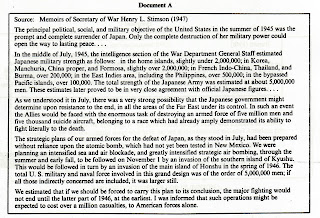How about a video first? If you are a history buff, you might like this YouTube clip of a PowerPoint on WWII in Europe.
Now check out some documents, cartoons, etc.!
1) Who, or what, was "America First" during World War II?
2) Who is napping in this cartoon, and what woke him/her/it up?
3) What does the cartoonist see as a problem in the USA during the war? How does this cartoon relate to the next cartoon?
4) What is a "5th Column?" What can you infer about the cartoonist's feelings toward Japanese-Americans during World War II from this cartoon? How does this cartoon relate to the previous cartoon?
5) Read the document below:- Where did Stimson feel the strength of the Japanese lay in the summer of 1945?
- What fears did Stimson have about the Japanese government?
- What did Stimson feel was the likely outcome of the war if the atomic bomb were not used?
- What is the main message Stimson was trying to put forward regarding the use of the bomb?
6) Read the document below:
- How did Truman justify the use of the atomic bomb against the Japanese?
- Why was he giving this address?
7) Read the documents below:
- What is the conclusion Arnold came to about the condition of Japan before the use of the atomic bomb?
- Did Eisenhower agree or disagree with Arnold's assessment of the condition of Japan?
- What was the point Eisenhower was trying to make about why it was, or was not, necessary to use the atomic bomb?
8) Does the term "appeaser" have a positive or negative connotation? What is the cartoonist implying in this cartoon, and who might "the appeaser" be (the cartoon was published August 13, 1941)?
9) For an animated map and some basic information on the Holocaust, click here.
10) And last, but not least, Donald Duck goes to war (1943) . . . check out the good duck/bad duck routine . . . how does this relate to the "Zoot Suit Riots" in Los Angeles?
10) And last, but not least, Donald Duck goes to war (1943) . . . check out the good duck/bad duck routine . . . how does this relate to the "Zoot Suit Riots" in Los Angeles?












No comments:
Post a Comment